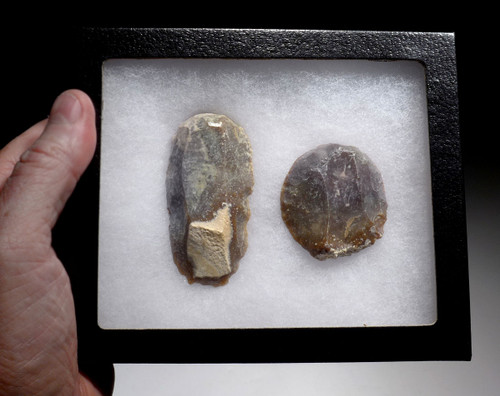Product Description
SEE MORE AFRICAN NEOLITHIC TOOLS AND ARTIFACTS
This is an IMMEASURABLY RARE and COMPLETE, UNBROKEN stone 4-sided cross-shaped discoidal mace head. It was fashioned out of hardstone and dates to the African Neolithic Capsian culture of Northwest Africa. It is sizable 4-bladed design with an upturned cross-sectional profile. The blade edges show actual prehistoric combat use damage. This damage is identical in patina to the undamaged regions, as well as sediment being impacted in all micro-crevices, providing irrefutable evidence that this damage is dated to the Neolithic. Out of 22 years of overseas travel to the Sahara, and having seen many large, museum-class collections and publications, THIS IS THE ONLY EXAMPLE OF THIS TYPE MACE HEAD WE HAVE EVER SEEN. The richly illustrated publications of African Sahara artifacts by Klenkler do not show a single example of this mace head, despite those publications being considered the "Bibles" of Sahara Prehistoric artifacts!
Stone discoidal mace heads have always been a scarce artifact of the Capsian Neolithic. Finding an authentic specimen that is unbroken, has always been a rare discovery, regardless of type. At this time in Africa's history, Neolithic warfare was known and no weapon would have been more intimidating and deadly as a heavy club fitted with a stone mace head like this example. The four radial blade processes would have broken bone and easily penetrated a skull with a single fatal blow. While we have offered a large variety of exceptional Capsian Neolithic tools and artifacts over the past two decades, this is only the third Capsian Neolithic stone mace head we have ever offered but, will FOREVER BE THE ONLY ONE with a cross-shaped radial blade design. The other two were simply ring mace heads. This NEOLITHIC OF CAPSIAN TRADITION artifact was found on an exposed African Neolithic site in the Sahara Desert in Northwest Africa. It was made and used by African Neolithic humans (Homo sapiens sapiens) between 8,500 and 6,500 years ago.
The entire surface is free from any modern alterations or grinding, and exhibits a rich wind-polished "desert varnish" patina, with microscopic minerals and sediment deep in all microscopic crevices - traits only found in authentic specimens.
WARNING: Many large stone African Neolithic artifacts have become scarce in today's market. Their size have made them easy to spot by nomads and most of the Northern Sahara has been picked clean of these Neolithic artifacts over the past 20 years. In Morocco, the RAMPANT trade and manufacture in fakes is astonishing, preying on people visiting thinking they are "buying at the source". In the western world auctions, online sellers, artifact shows and especially on Ebay, fakes dominate the market. In our travels to North Africa as far back as 15 years ago, we saw a tremendous quantity of convincing fakes being produced for the collector market. Deal only with highly knowledgeable and reputable sellers who offer a written guarantee of authenticity with no conditions or expiration time!
 US DOLLAR
US DOLLAR
 EURO
EURO
 AUSTRALIAN DOLLAR
AUSTRALIAN DOLLAR
 CANADIAN DOLLAR
CANADIAN DOLLAR
 POUND STERLING
POUND STERLING




















